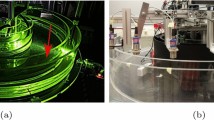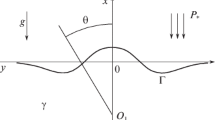Abstract
The results of a numerical investigation of the angle of water entry of a body on the parameters of the waves generated in the near zone are presented. The disturbed region dimensions are studied and the laws of variation of the source parameters are established. It is shown that the cavity parameters most intensely vary at the body fall angles greater than 20° and obey a quasilinear law. The variation intensity increases with increase in the velocity, while the tendency of the linear law is conserved. The water entry of a body at an angle smaller than 20° occurs in accordance with another scenario, where the body can under certain conditions rebound from the water surface, while the disturbed region boundaries are rather smeared.
Similar content being viewed by others
References
M. A. Lavrent’ev and B. V. Shabat, Problems of Fluid Dynamics and Their Mathematical Models [in Russian], Nauka, Moscow (1973).
V. I. Bukreev and A. V. Gusev, “Gravity Waves Produced upon Body Fall on Shallow Water,” Zh. Prikl. Mekh. Tekhn. Fiz. 37 2, 90 (1996).
S. Gekle, I. R. Peters, J. M. Gordillo, D. van der Meer, and D. Lohse, “Supersonic Air Flow Due to Solid-Liquid Impact,” Phys. Rev. Lett. No. 104, 024501 (2010).
J. M. Aristoff, “On Falling Spheres: The Dynamics of Water Entry and Descent along a Flexible Beam,” Ph. D. Thesis, Massachusetts Inst. Technol. (2009).
E. Pierazzo, N. Artemieva, E. Asphaug, E. C. Baldwin, J. Cazamias, R. Coker, G. S. Collins, D. A. Crawford, T. Davison, D. Elbeshausen, K. A. Holsapple, K. R. Housen, D. G. Korycansky, and K. Wunemann, “Validation of Numerical Codes for Impact and Explosion Cratering: Impacts on Strengthless and Metal Targets,” Meteoritics Planet. Sci. 43, 1917 (2008).
A. V. Komarov and V. V. Kazennov, “Body Fall into a Reservoir Filled with a Liquid and Calculations of the Occurring Dynamic Loads,” Vestn. FGBOU VPO “MGSU”. Ser. Gidravl. Inzh. Gidrologiya. Gidrotekhn. Stroi. No. 5, 135 (2014).
A. S. Kozelkov, A. A. Kurkin, and E. N. Pelinovskii, “Cosmogenic Tsunami,” Trudy Nizhniy Novgorod Gos. Tekhn. Univ. No. 2 104, 26 (2014).
G. V. Logvinovich, Hydrodynamics of Flows with Free Boundaries [in Russian], Naukova Dumka, Kiev (1969).
A. S. Kozelkov, A. A. Kurkin, E. N. Pelinovskii, and V. V. Kurulin, “Modeling the Cosmogenic Tsunami within the Framework of the Navier–Stokes Equations with Sources of Different Types,” Fluid Dynamics 50 2, 306 (2015).
A. S. Kozelkov, “Effects Accompanying the Meteorite Entry into the Water Medium,” Trudy Nizhniy Novgorod Gos. Tekhn. Univ. No. 3 105, 48 (2014).
E. N. Pelinovskii, Hydrodynamics of Tsunami Waves [in Russian], Inst. Appl. Physics, Nizhniy Novgorod (1996).
S. N. Ward and E. Asphaug, “Asteroid Impact Tsunami: A Probabilistic Hazard Assessment,” Icarus 145, 64 (2000).
C. Kharif and E. Pelinovsky, “Asteroid Impact Tsunamis,” C. R. Physique 6, 361 (2005).
V. Badescu and D. Isvoranu, “Dynamics and Coastal Effects of Tsunamis Generated by Asteroids Impacting the Black Sea,” Pure Appl. Geophys. 168, 1813 (2011).
C. W. Hirt, and B. D. Nichols, “Volume of Fluid (VOF) Method for the Dynamics of Free Boundaries,” J. Comput. Phys. 39, 201 (1981).
O. Ubbink, “Numerical Prediction of Two Fluid Systems with Sharp Interfaces,” PhD Thesis, Imperial College, Univ. London (1997).
A. Zh. Zhainakov and A. Y. Kurbanaliev, “Verification of the OpenFOAM Open Package against the Dam Breakthrough Problems,” Teplofiz. Aeromekh. 20, 461 (2013).
J. Horrillo, A. Wood, G. B. Kim, and A. Parambath, “A Simplified 3-D Navier–Stokes Numerical Model for Landslide-Tsunami: Application to the Gulf of Mexico,” J. Geophys. Res.: Oceans 118, 6934 (2013).
K. N. Volkov and V. N. Emel’yanov, Gas Flows with Particles [in Russian], Fizmatlit, Moscow (2008).
A. S. Kozelkov, V. V. Kurulin, E. S. Tyatyushkina, O. L. Puchkova, and S. V. Lashkin, “Detached Eddy Simulation of Turbulent Viscous Incompressible Flows on Unstructured Grids,” Mat. Model. 26 8, 81 (2013).
A. S. Kozelkov, Yu. N. Deryugin, Yu. A. Tsibereva, A. V. Kornev, O. V. Denisova, D. Yu. Strelets, A. A. Kurkin, V. V. Kurulin, I. L. Sharipova, D. P. Rubtsova, M. A. Legchanov, E. S. Tyatyushkina, S. V. Lashkin, A. V. Yalozo, S. V. Yatsevich, N. V. Tarasova, R. R. Ginniyatullin, M. A. Sizova, and O. L. Krutyakova, “Minimal Basis of Problems forValidatingMethods of Numerical Simulation of TurbulentViscous Incompressible Flows,” TrudyNizhniy Novgorod Gos. Tekhn. Univ. No. 4(104), 21 (2014).
A. S. Kozelkov and V. V. Kurulin, “Numerical Scheme forModeling Incompressible Turbulent Flows Using Eddy-ResolvingModels,” Zh. Vychisl. Mat. Mat. Fiz. 55 7, 135 (2015).
A. Kozelkov, V. Kurulin, V. Emelyanov, E. Tyatyushkina, and K. Volkov, “Comparison of Convective Flux Discretization Schemes in Detached Eddy Simulation of Turbulent Flows on Unstructured Meshes,” J. Sci. Comput. DOI. doi 10. 1007/s10915-015-0075-7 (2015).
M. Darwish, I. Sraj, and F. Moukalled, “A Coupled Finite Volume Solver for the Solution of Incompressible Flows on Unstructured Grids,” J. Comput. Phys. 228, 180 (2009).
J. H. Ferziger and M. Peric, Computational Methods for Fluid Dynamics, Springer, Berlin (2002).
R. Mittal and G. Iaccarino, “Immersed Boundary Methods,” Annu. Rev. Fluid Mech. 37, 239 (2005).
A. Posa, A. Lippolis, R. Verzicco, and E. Balaras, “Large-Eddy Simulations in Mixed-Flow Pumps Using an Immersed-Boundary Method,” Computers Fluids 47 1, 33 (2011).
K. N. Volkov, Yu. N. Deryugin, V. N. Emel’yanov, A. S. Kozelkov, and I. V. Teterina, Difference Schemes in Gasdynamic Problems on Unstructured Grids [in Russian], Fizmatlit, Moscow (2014).
A. S. Kozelkov, Yu. N. Deryugin, S. V. Lashkin, D. P. Silaev, P. G. Simonov, and E. S. Tyatyushkina, “Realization of the Method of Calculating Viscous Incompressible Flows Using a Multigrid Technique Based on the SIMPLE Algorithm in the LOGOS Software Package,” VANT. Mat. Model. Fiz. Proc. Issue 4, 44 (2013).
A. A. Golubev, Yu. N. Deryugin, D. K. Zelenskii, A. S. Kozelkov, S. V. Lashkin, D. P. Silaev, and P. G. Simonov, “LOGOS Software Package. Development and Implementation of an Algebraic MultigridMethod,” in: R. M. Shagaliev (ed. ) Supercomputations and Mathematical Modeling. Works of XIV Intern. Conf. [in Russian], Sarov (2013), p. 175.
K. N. Volkov, Yu. N. Deryugin, V. N. Emel’yanov, A. G. Karpenko, A. S. Kozelkov, and I. V. Teterina, Methods of Accelerating Gasdynamic Calculations on Unstructured Grids [in Russian], Fizmatlit, Moscow (2103).
V. B. Betelin, R. M. Shagaliev, S. V. Aksenov, I. M. Belyakov, Yu. N. Deryugin, D. A. Korchazhkin, A. S. Kozelkov, V. F. Nikitin, A. V. Sarazov, and D. K. Zelenskiy, “Mathematical Simulation of Hydrogen-Oxygen Combustion in Rocket Engines Using LOGOS Code,” Acta Astronaut. 96, 53 (2014).
A. S. Kozelkov, V. V. Kurulin, O. L. Puchkova, and S. V. Lashkin, “Modeling Turbulent Flows Using the Algebraic Reynolds-Stress Model with UniversalWall Functions,” Vychisl. Mekh. Sploshnykh Sred 7 1, 40 (2014).
A. S. Kozelkov, S. V. Lashkin, V. V. Kurulin, M. A. Sizova, D. P. Rubtsova, and E. S. Tyatyushkina, “Modern Approaches to the Turbulent Flow Modeling. Realization and Experience of Using the LES and DES Models in the Software Package LOGOS,” in: R. M. Shagaliev (ed. ), Supercomputations and Mathematical Modeling. Proc. XIV Intern. Conf. [in Russian], Sarov (2013), p. 344.
A. S. Kozelkov, A. A. Kurkin, I. L. Sharipova, V. V. Kurulin, E. N. Pelinovskii, E. S. Tyatyushkina, D. P. Meleshkina, S. V. Lashkin, and N. V. Tarasova, “Minimal Basis of the Problems for ValidatingMethods of Calculations of Flows with a Free Surface,” Trudy Nizhniy Novgorod Gos. Tekhn. Univ. No. 2(109), 49 (2015).
A. V. Minakov, A. A. Gavrilov, and A. A. Dekterev, “Numerical Algorithm for Solving Three-Dimensional Fluid Dynamics Problems with Movable Solid Bodies and a Free Surface,” Sib. Zh. Industr. Mat. 11, No. 4(36), 94 (2008).
A. S. Kozelkov, A. A. Kurkin, and E. N. Pelinovskii, “Modeling Body Fall into the Water on the Basis of the Numerical Solution of the Navier–Stokes Equations Using a Fully Implicit Method,” Trudy Nizhniy Novgorod Gos. Tekhn. Univ. No. 3(110), 26 (2015).
T. Truscott, J. Belden, and R. Hurd, “Water-Skip** Stones and Spheres,” Physics Today 67(12), 70 (2014).
Author information
Authors and Affiliations
Corresponding author
Additional information
Original Russian Text © A.S. Kozelkov, A.A. Kurkin, E.N. Pelinovskii, 2016, published in Izvestiya Rossiiskoi Akademii Nauk, Mekhanika Zhidkosti i Gaza, 2016, Vol. 51, No. 2, pp. 166–176.
Rights and permissions
About this article
Cite this article
Kozelkov, A.S., Kurkin, A.A. & Pelinovskii, E.N. Effect of the angle of water entry of a body on the generated wave heights. Fluid Dyn 51, 288–298 (2016). https://doi.org/10.1134/S0015462816020162
Received:
Published:
Issue Date:
DOI: https://doi.org/10.1134/S0015462816020162




